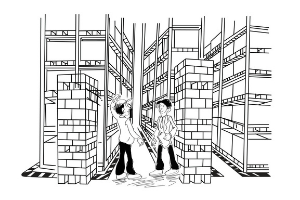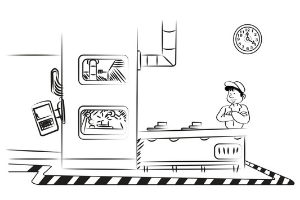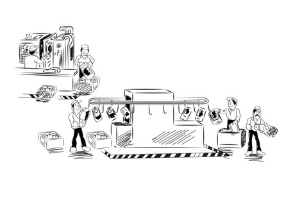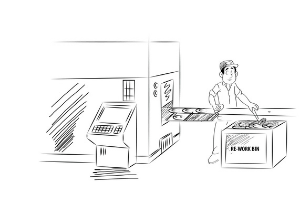During the value stream mapping process, make sure you and your team members look for the 8 wastes. These 8 types of waste (or non-value-added time and effort) are known by the acronym T I M W O O D I. Here are the common wastes you’ll come across in services:
Table 1 – Types of wastes and examples in services

Waste 1: Transport
Transportation itself is not a waste. However, excess transport is! It can be a result of several causes, such as:
- Firstly, having a poor layout design.
- Secondly, comprising of high batch size.
- Thirdly, possessing a poor process flow design.
- Fourthly, being a victim of overproduction.
- Fifthly, having line and capacity imbalances.
- Lastly, making use of unnecessary rework.

Figure 1 – Excess transport in manufacturing
Waste 2: Inventory
Excess inventory is another type of waste. Here are some of its causes:
(Most importantly, note that a cause can result in more than one waste!)
- Inaccurate demand estimation
- Batch production
- Poor layout design
- Uncontrolled batch size
- Substandard process flow design
- Overproduction
- Line/capacity imbalances
- High ordering lead time.
- RM cost variations

Figure 2 – Excess inventory in manufacturing
Waste 3: Motion
Excess motion is the third type of waste. Without motion, it is impossible to produce anything in manufacturing. For instance, a screwdriver, jig, or fixture that is found near the point of use causes repetitive motion. Therefore, it triggers operators to feel fatigued. Most importantly, remember that motion waste is unavoidable if the workplace lacks an ergonomic design.
Here are some potential causes of excess motion:
- Firstly, having a poor workstation layout design.
- Secondly, possessing a substandard layout design.
- Thirdly, having a faulty process flow.
- Lastly, being a victim of an inferior process flow design.
Waste 4: Waiting
Now, this is a tricky waste to identify. Sometimes, waiting can be for a good reason. For instance, waiting to produce till there is customer demand, or waiting for customer approval of a drawing! Therefore, you must use your judgment, based on the scenario you face. Here are some of the potential causes of waiting:
- Firstly, an uncontrolled batch size can cause unnecessary delay.
- Secondly, having overproduction.
- Thirdly, line and capacity imbalances further contribute to this type of waste.
- Fourthly, having poor information flow.
- Fifthly, not possessing adequate information.
- Lastly, having unnecessary or excessive rework.

Figure 3 – Waiting in manufacturing
Waste 5: Over-processing
Over-processing is a waste of excess effort. Therefore, it involves carrying out more steps or spending more time in a step than is necessary. The most common reason for over-processing is poor process or product design. However, make sure you note these other causes as well:
- Firstly, having unnecessary or continuous rework done.
- Secondly, involving deviations from SOP and no SOP (standard operating procedure).
- Thirdly, having an insufficient understanding of customer needs.
- Most importantly, possessing substandard process and product designs.

Figure 4 – Over-processing in manufacturing
Waste 6: Overproduction
Overproduction results in uncontrolled inventory between steps. Eventually, it causes slow or non-moving stocks in finished goods warehouses. Furthermore, it involves the production of more items than the next step can handle. The causes of overproduced goods are:
- Firstly, producing to capacity and not to demand.
- Secondly, a lack of flow and line balance aided with the movement of uncontrolled inventories.
Waste 7: Defects
This waste is self-explanatory. I’m sure you will have enough experience in seeing defects (or nonconforming products) in your day-to-day work! These are the potential causes of defect:
- Substandard quality of raw material
- Poor process design
- Inferior product design
- Deviations from SOP
- Insufficient understanding of customer needs
- Lack of preventive approach
- A shortfall of reliable quality practices
- Performance measures mostly aligned with production numbers
- Lack of ‘ownership’

Figure 5 – Defects in manufacturing
Waste 8: Intellectual Waste
This is the mother of all wastes! Are we using our intellect to its true potential? Do we think freely to prevent problems? Do we think in the right direction at the right time?
If your answers to these questions are a ‘no’, it indicates intellectual waste. Hence, to eliminate them, make note of its potential causes:
- Work without numerical goals
- Misaligned company policies
- No alignment between the vision and the voice of the market
- Demand and capacity misalignment
- Poor infrastructure
- Outdated technology
- Lack of continuous improvement culture
- Unavailability of world-class practices
- Backward thinking labour unions
Want to engage in effective waste management? Lean is your answer! So, check out the 5 Lean principles which can help you minimize waste in your organization today.

Very nice write up Sridhar